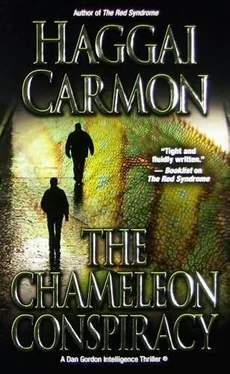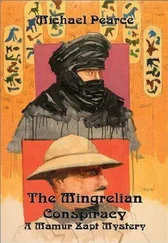Haggai Harmon - The Chameleon Conspiracy
Здесь есть возможность читать онлайн «Haggai Harmon - The Chameleon Conspiracy» весь текст электронной книги совершенно бесплатно (целиком полную версию без сокращений). В некоторых случаях можно слушать аудио, скачать через торрент в формате fb2 и присутствует краткое содержание. Жанр: Триллер, на английском языке. Описание произведения, (предисловие) а так же отзывы посетителей доступны на портале библиотеки ЛибКат.
- Название:The Chameleon Conspiracy
- Автор:
- Жанр:
- Год:неизвестен
- ISBN:нет данных
- Рейтинг книги:5 / 5. Голосов: 1
-
Избранное:Добавить в избранное
- Отзывы:
-
Ваша оценка:
- 100
- 1
- 2
- 3
- 4
- 5
The Chameleon Conspiracy: краткое содержание, описание и аннотация
Предлагаем к чтению аннотацию, описание, краткое содержание или предисловие (зависит от того, что написал сам автор книги «The Chameleon Conspiracy»). Если вы не нашли необходимую информацию о книге — напишите в комментариях, мы постараемся отыскать её.
The Chameleon Conspiracy — читать онлайн бесплатно полную книгу (весь текст) целиком
Ниже представлен текст книги, разбитый по страницам. Система сохранения места последней прочитанной страницы, позволяет с удобством читать онлайн бесплатно книгу «The Chameleon Conspiracy», без необходимости каждый раз заново искать на чём Вы остановились. Поставьте закладку, и сможете в любой момент перейти на страницу, на которой закончили чтение.
Интервал:
Закладка:
“Please meet Parviz Morad,” said Benny. I looked at the stranger. He was wearing clothes that were about one or two sizes bigger than his frame. His dark eyes were sunken and his wrinkled cheeks fallen. His face was gloomy. He seemed so humble, looking at us as if he were waiting for instructions.
Benny touched the man’s shoulder and said, “Please sit here with us.” The man complied.
“Mr. Parviz Morad was born in Tehran in 1962 to an army col o nel who had been the Iranian military attache in London for two years during the reign of the Shah. Parviz attended the American School in Tehran from first grade through fourth, and from seventh through twelfth grades. He attended fifth and sixth grades in London.”
Born in 1962? He was only forty-three, but looked decades older.
At Benny’s prompting, Morad began to speak, in English with a slight British accent. “In late 1979 I was drafted into a highly selective unit of young Iranian men. We were sent to a heavily guarded location in northern Tehran, which before the revolution was used as a club for foreign military officers. We were subjected to daily religious indoctrination and teaching of strict rules of Islamic behavior according to Ayatollah Khomeini’s interpretation of Islam.”
“Please tell my friend the name of that unit,” said Benny.
“It was code-named Atashbon, Farsi for the guardians of fire,” he answered, lowering his eyes.
I was staggered. So that’s what Benny had meant. Parviz Morad was my farewell present.
CHAPTER SEVENTEEN
I hid my surprise. “How many of you were in Atashbon?” I asked.
“Eighteen or twenty, I don’t remember exactly.”
“Was it all religious indoctrination?” I asked.
“No. After the religious immersion that lasted six months, we were given military training and an additional six-month course in intelligence gathering and communications.”
“Where were you located?”
“Department 81 maintained a top-secret center in the suburbs of Tehran, code-named Agdassieh Post, and another satellite office, Shiraz Post.”
“Were you the only group to be trained there?”
He shook his head. “No. We discovered later that this place was used also for training combatants to carry out terrorist attacks, assassinations, and kidnappings outside Iran. We were also trained at Imam Hussein Post, usually used by a regional unit attached to the Revolutionary Guards-Pasdaran-e Enghelab-e Islami. That location was also used as a training center for sabotage and other terrorist activities in foreign countries.”
“When you were selected, did you know why?” I asked.
He shook his head. “No.”
“They never told you why you were assembled together, separated from your families and friends?” His soundtrack sounded untrustworthy.
“We immediately recognized that we were all graduates of the American School in Tehran. We speculated that we were sent there for reeducation to rid us of the satanic doctrines of America. When we asked why we were selected, we were told that we would soon find out. We then had military and clandestine-operation training. We realized they had specific tasks for us.”
“Did you already know the other cadets?” I asked.
“Just two or three, and not even by name.” He moved his eyes and looked toward the window. We have a problem here, I thought.
“What happened after the training ended?”
“We were taken to a meeting with an ayatollah, who told us how we should be proud to be chosen to fight for the Islamic Revolution,” he answered. “He said that the Americans are infidel pigs and sons of monkeys who think that with the might of the Great Satan they can bring true believers down. ‘They have no honor,’ he said. ‘You will give them a lesson they’ll remember.’ ”
“And what was that lesson? Did he say?”
“No, he only said that our instructors would tell us. We returned to our base, and Bahman Hossein Rashtian, our commander, told us what was expected of us.”
“And?” I said, struggling to keep the impatience out of my voice.
“Rashtian told us that the revolution was counting on us to destroy America. We were going to be sent to the United States using stolen identities and establish ourselves as regular U.S. citizens. Once we were immersed in a community, we were to receive instructions from Tehran.”
“Did he tell you specifically how you would assume American identities?”
“Yes, we actually had training classes on that. They told us how they got the first American passport. Our instructor told us about the German archaeological team and its request to allow an American photographer to enter Iran. That request was brought to the attention of our commander, Bahman Hossein Rashtian. He boasted that he immediately identified the potential. Since the capture of the American Embassy and its diplomats, no American dared set foot in Iran. But if that photographer would agree to come to Iran, Atashbon’s first project could be launched. He told us that since all the outgoing and incoming mail of foreigners in Iran was opened, he knew exactly what to do.
“Rashtian called the American photographer, posing as a member of the archaeological group, and offered Ward a job for $500 a month for three months. Rashtian told us that according to the visa application filed by the archaeological expedition, Ward’s parents were no longer living. Rashtian then questioned Fischer about Albert’s finances under the guise of investigating Albert’s ability to support himself in Iran. Fischer told him that Albert was living on $5 a day. That, Rashtian told us, gave him the idea how to lure Albert into Iran.”
“Wasn’t Ward hesitant?” I asked.
“Yes, but when he heard that the first month’s salary would be paid up front, directly into his bank account outside Iran, he gave in.”
“Do you know what happened to Ward?”
“He was killed by Rashtian’s men. We heard from Rashtian that before killing Ward they had extracted from him information about his life. It took some time, because he stuttered.”
“And then?”
“Kourosh Alireza Farhadi, a member of Atashbon, with physical characteristics similar to Ward’s, was chosen to step into Ward’s identity.”
“Tell us about Atashbon and Department 81,” said Casey. “Department 81 had several hundred staff members. Our unit of American School graduates was Atashbon. Both were operated under the overall command and supervision of Bahman Hossein Rashtian.”
“Did Department 81 have other missions?”
“Yes, but I have no specific knowledge. We were kept apart from the others.”
“How do you know all this about Ward?” I asked. It seemed suspicious that the Iranians hadn’t compartmentalized the information, a must in any intelligence operation.
“Since it was the first case, we were all participating in the process to learn how to do it with the next American that was caught.”
“Then what happened?” I asked.
“After viewing Ward’s five-hour eight-millimeter film interview many times, and rehearsing his new role as Albert Ward, Kourosh Alireza Farhadi was given Ward’s passport and other documents and was flown from Europe to Toronto, Canada.”
“Do you know which country in Europe?”
“No. They didn’t tell us. Later on, we were told that after a few days in Toronto, Farhadi, now posing as Albert Ward, boarded a bus and crossed the border to the U.S.”
It had been that easy, I realized. In those days, there had been very little or no inspection at the U.S.-Canadian border. At many border crossings, there had been no immigration inspection, only customs officers interested if the passenger was bringing any fresh food from Canada. No entry stamps had been used for returning U.S. citizens, and no record of the entry had been made.
Читать дальшеИнтервал:
Закладка:
Похожие книги на «The Chameleon Conspiracy»
Представляем Вашему вниманию похожие книги на «The Chameleon Conspiracy» списком для выбора. Мы отобрали схожую по названию и смыслу литературу в надежде предоставить читателям больше вариантов отыскать новые, интересные, ещё непрочитанные произведения.
Обсуждение, отзывы о книге «The Chameleon Conspiracy» и просто собственные мнения читателей. Оставьте ваши комментарии, напишите, что Вы думаете о произведении, его смысле или главных героях. Укажите что конкретно понравилось, а что нет, и почему Вы так считаете.












